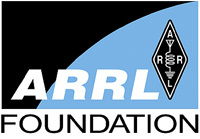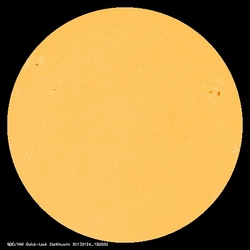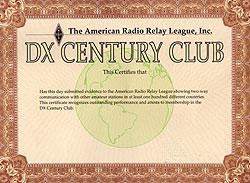 January 24, 2013 John E. Ross, KD8IDJ, Editor
| |||||||||
+ Available on ARRL Audio News. + ARRL Board Holds 2013 Annual Meeting
The ARRL Board of Directors held its 2013 Annual Meeting January 18-19 in New Orleans, Louisiana. At the meeting, the Board set its legislative objectives for the 113th Congress, bestowed awards, approved the organization's amended financial plan, elected members to the Executive Committee and ARRL Foundation, and more. A detailed look at all the Board's actions, including the official minutes from the meeting, is forthcoming. + Amateur Radio and Scouting: BSA to Offer Amateur Radio Operator Rating Strip
The Boy Scouts of America (BSA) has approved an Amateur Radio Operator rating strip for Scouts and Scouters to wear on their uniforms. According to BSA Communication Services Director Jim Wilson, K5ND, the strip recognizes the Scout or Scouter's availability as an Amateur Radio operator for communication services for events and activities, as well as emergencies. All registered youth members and adult leaders who also hold a valid FCC-issued Amateur Radio license of any class are eligible to wear the rating strip. Read more here. + ARRL Scholarship Deadline Is February 1
The application deadline for ARRL Foundation Scholarships is fast approaching. The deadline for applications is February 1, 2013. According to ARRL Foundation Secretary Mary Hobart, K1MMH, the 2013 collection of scholarship awards is bigger than ever, with eight new scholarships added in 2012. "The annual awards range from $500 to $2500, while the Goldfarb Scholarship can total upwards of $10,000 each year," Hobart explained. "The estimated total dollar amount of all awards in excess of $80,000." Scholarship recipients will be announced in May 2013 via letter and on the ARRL website. "The message today is clear -- there is still time to apply for one of the many scholarships administered by the ARRL Foundation," Hobart said. "If you know a young radio amateur who is pursuing higher education, please encourage him or her to apply. If you are a club officer, add this information to your website. With several new awards added every year, highly qualified young hams should review the list of available scholarships, complete the electronic application form and submit it -- along with a recent academic transcript -- before February 1." Information about all of the ARRL Foundation awards -- including descriptions and selection criteria, application forms and instructions -- is available on the ARRL Foundation website. The ARRL Foundation is an IRS-designated 501(c)(3) organization dedicated to Amateur Radio. The Doctor is In: More Power for EME Stations Carl Hasbargen, KN0WS, of St Paul, Minnesota, wrote to the ARRL's Doctor, wanting to know how to use more transmit power for the new Earth-Moon-Earth (EME) station that he plans to build later this year. In the past, he has used a portable generator to power a 180 W, 432 MHz linear amplifier into a quad Yagi antenna system. While Hasbargen was successful using that setup to make a contact via the Moon, he figures additional transmit power would be helpful. He told the Doctor that he would like to be able to use his current generator. Hasbargen asked "If I have two identical model solid state linear amplifiers, each capable of amplifying a 25 W input into a 180 W output, can I simply take the 50 W from my transceiver, divide the power using a commercial antenna power divider to drive each linear amplifier, then combine the two 180 W outputs from the pair of amplifiers back through another power divider (used backwards as a coupler) to produce a final 360 W to the antenna?" Here's what the Doctor had to say:
If you pull off the covers of many high power solid state amplifiers, you will see that is exactly how they are constructed internally (see photo). While it seems like a straightforward idea, the main issue, especially at EME frequencies, is relative phase delay. While a single dual-module amplifier is relatively easy to build and test as an integrated system, your separate amplifiers were not built with that in mind. At 70 centimeters, a wavelength is 70 centimeters long, but 1/10 of a wavelength is only 7, about 5 centimeters, or 2 inches in coax. I would think you would want tolerances to accumulate to well less than that for reasonable operation, and with independent assembly and device selection (not selected as matched components) and alignment, I would be surprised if two randomly selected amplifiers would be that close. If you have the capability to phase match them, the difference, if any, could be accommodated in a short length of coax, preferably on the input side. If the amplifiers are linear and can amplify at very low levels, it would be safe...to drive them with an input splitter and measure the power at each output. If they are the same and you put them in a combiner and the level is twice each, less the attenuation of the combiner, you are probably good to go. I would bring up the power slowly and watch for heating and other undesired effects. Of course, in real life, each of the power divider/combiners will introduce a little loss, so don't expect the full 360 W -- still it should be close. Thanks Doctor! Do you have a question or a problem? Send your questions via e-mail or to "The Doctor," ARRL, 225 Main St, Newington, CT 06111 (no phone calls, please). Look for "The Doctor Is In" every month in QST, the official journal of the ARRL. + On the Air: Icelandic Amateurs Get MF Privileges
According to the Íslenskir Radíóamatörar (ÍRA) -- Iceland's IARU Member-Society -- radio amateurs in Iceland now have operating privileges on 472-479 kHz, or 630 meters, as of January 16. Amateurs in Germany, Sweden, the Netherlands, New Zealand and Monaco already have operating privileges in this portion of the MF spectrum. Delegates at the 2012 World Radiocommunication Conference approved this method of addressing Agenda Item 1.23, as the Conference considered a possible allocation of approximately 15 kilohertz between 415 and 526.5 kHz. After discussions and taking into account spectrum conflicts with the Maritime Mobile Service, delegates ultimately decided to allocate 472-479 kHz to the Amateur Radio Service on a secondary basis. Read more here. Solar Update
Tad Cook, K7RA, reports: The average daily sunspot numbers this past week dropped nearly 73 points to 56.4, while the average daily solar flux declined nearly 47 points to 110.7. The average geomagnetic indices were up about 50 percent, but it was still very quiet. The difference was mostly due to events on January 17 when the planetary A index was 13 -- higher than in recent weeks, but still moderate. The cause of the mild disturbance was the arrival of a coronal mass ejection (CME). The predicted solar flux from the NOAA/USAF January 23 forecast has the 10.7 centimeter flux values at 105 on January 24, 100 on January 25-28, 95 on January 29-30, 100 on January 31-February 1, 110 on February 2, 120 on February 3-4, 125 on February 5-8, 120 on February 9-14, and 115 on February 15. It doesn't look like a return to solar flux values around 170 -- where it was on January 9-12 -- is expected any time soon. But those high levels that we saw earlier in the month weren't predicted, either. Looking back, 135 was predicted for January 9 in the November 25-December 9 daily forecasts, then downgraded to 110 on December 10-16, then increased to 115 on December 17-30, downgraded to 105 on December 31-January 2, increased to 115 on January 3, 135 on January 4, 130 on January 5-6, 145 on January 7, and 150 on January 8. The final result? On January 9, we saw 169.3, far above any of the predictions over the previous 45 days, which were revised eight times. The predicted planetary A index is 5 on January 24, 8 on January 25-26, 5 on January 27-February 8, 8 on February 9-10, and 5 on February 11-18. Look for more on the ARRL website on Friday, January 25. For more information concerning radio propagation, visit the ARRL Technical Information Service Propagation page. + Postage Rates to Rise this Month
Beginning Sunday, January 27, it will cost more to mail first class letters, postcards and packages within the US. The cost to mail a first class letter will be 46 cents, while the cost to mail a postcard will be 33 cents, an increase of 1 cent for each; this is the third increase for postcard postage in less than two years. This month, the USPS will also introduce a First Class Mail Global Forever Stamp that will allow customers to mail 1-ounce letters anywhere in the world for one set price of $1.10. The cost to mail flat-rate Priority Mail packages and letters will also increase. Click here for more information on all the postal increases. + DXCC Desk Approves Two Laotian Operations
ARRL DXCC Manager Bill Moore, NC1L, reports that the 2010-2011 XWPA operation and the current XW4XR operation in Laos have been approved for DXCC credit. "If you have had these operations rejected in a recent application, please send an e-mail to the ARRL DXCC Desk," Moore said. "Once updated, results will appear in Logbook of The World (LoTW) accounts, as well as online in the daily listings." This Week in Radiosport This week:
Next week:
All dates, unless otherwise stated, are UTC. See the ARRL Contest Branch page, the ARRL Contest Update and the WA7BNM Contest Calendar for more information. Looking for a Special Event station? Be sure to check out the ARRL Special Event Stations web page. Upcoming ARRL Section, State and Division Conventions and Events
To find a convention or hamfest near you, click here. ARRL -- Your One-Stop Resource for Amateur Radio News and Information Join or Renew Today! ARRL membership includes QST, Amateur Radio's most popular and informative journal, delivered to your mailbox each month. Subscribe to NCJ - the National Contest Journal. Published bi-monthly, features articles by top contesters, letters, hints, statistics, scores, NA Sprint and QSO Parties. Subscribe to QEX -- A Forum for Communications Experimenters. Published bi-monthly, features technical articles, construction projects, columns and other items of interest to radio amateurs and communications professionals. Free of charge to ARRL members: Subscribe to the ARES E-Letter (monthly public service and emergency communications news), the ARRL Contest Update (bi-weekly contest newsletter), Division and Section news alerts -- and much more! Find us on Facebook. Follow us on Twitter. ARRL offers a wide array of products to enhance your enjoyment of Amateur Radio. Donate to the fund of your choice -- support programs not funded by member dues! Click here to advertise in this newsletter (subject to space availability). | |||||||||















